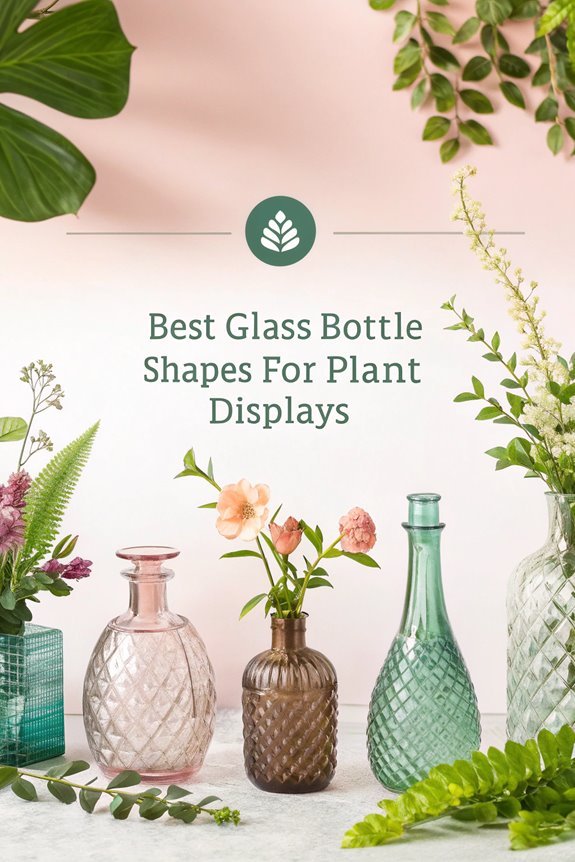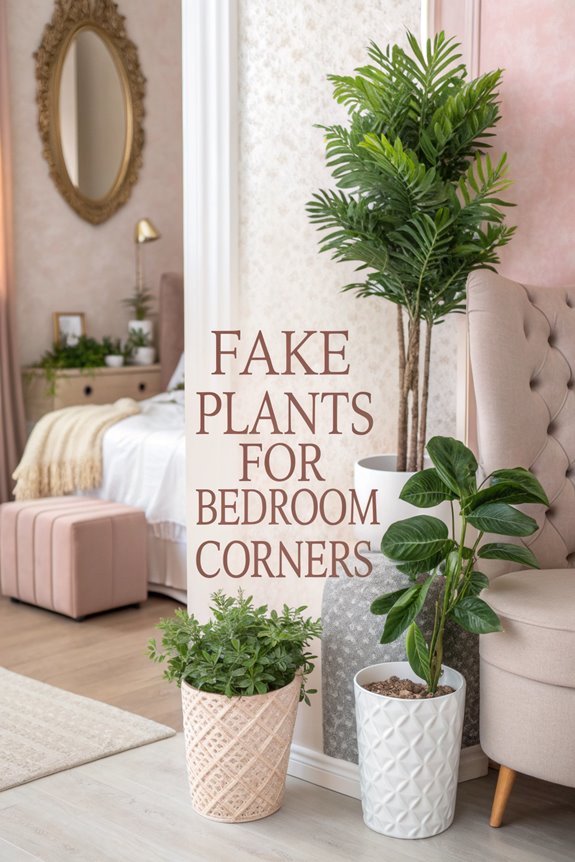25 Living Room Plant Decor Mistakes to Avoid
Overloading your living room with plants won’t create a jungle paradise but may lead to chaos. Mistakes like selecting the wrong plant size and ignoring lighting conditions can hinder your green aspirations.
Avoid these common pitfalls to craft a balanced, stunning space that your plants will thrive in and you will love.
Choosing the Wrong Plant Size for Your Space
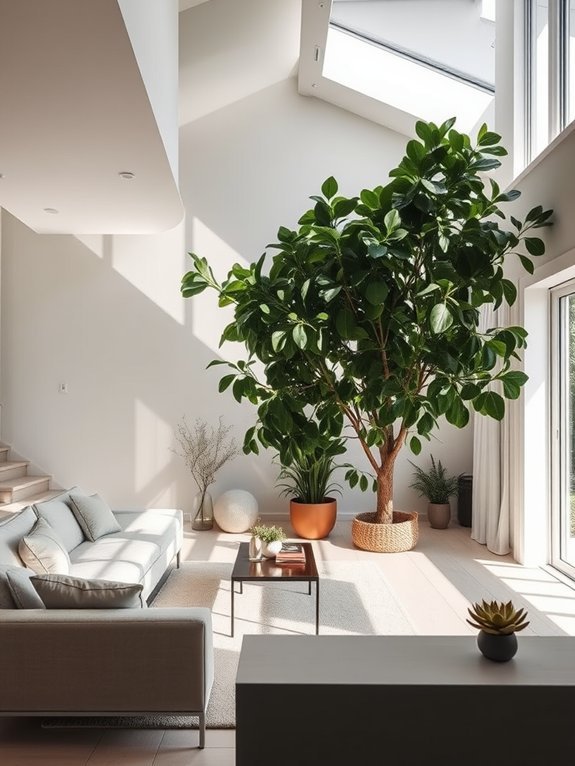
Have you ever walked into a living room and felt like a tiny mouse next to a towering plant? It’s easy to get carried away by the allure of those lush greens, but size matters!
A giant plant can overpower your cozy space, making you feel like you’re in a jungle. On the flip side, a tiny plant can get lost on a large shelf, leaving your room feeling bare.
Think about your room’s scale—balance is key! Embrace plants that fit your space, creating harmony while adding life.
After all, you want your plants to complement, not dominate your delightful living area!
Ignoring Lighting Conditions

When you’re picking out plants for your living room, don’t overlook the lighting conditions—after all, plants can be a bit picky about their light!
Some love the sun, while others prefer a cozy, shady spot. Check how much natural light your space gets throughout the day; it’ll help you choose the right green friends.
A sunny windowsill might be perfect for a cheerful succulent, but a low-light corner could spell disaster for a tropical fern.
Remember, choosing the right plant for your lighting is like finding the perfect dance partner—it’s all about compatibility!
Overcrowding With Too Many Plants
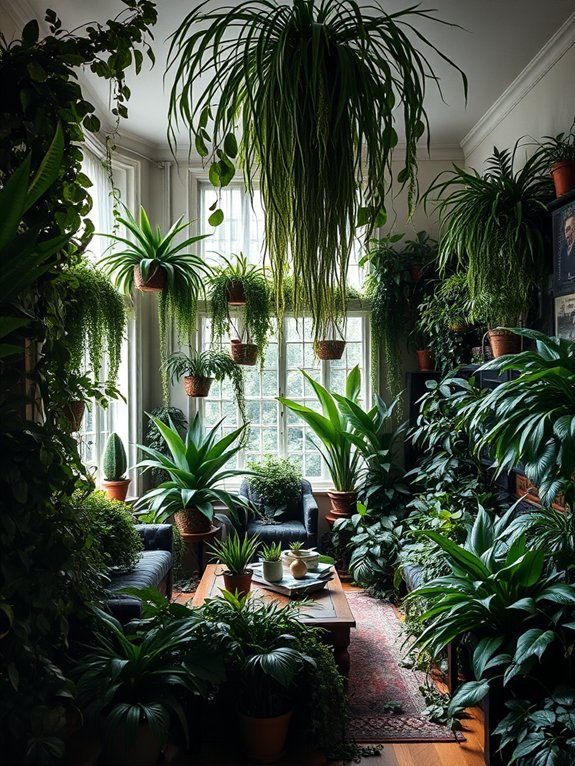
While it’s tempting to fill every nook and cranny of your living room with a variety of plants, overcrowding can lead to more problems than you might expect.
Imagine this: a jungle of greenery where your favorite plant gets lost in the chaos! Not only can too many plants compete for light, but they can also create a cluttered look that distracts from your decor.
Remember, less can be more! Choose a few statement plants that can shine, and let them breathe.
Your living room deserves space to shine, too—both for you and your leafy friends! Happy decorating!
Neglecting Plant Care and Maintenance
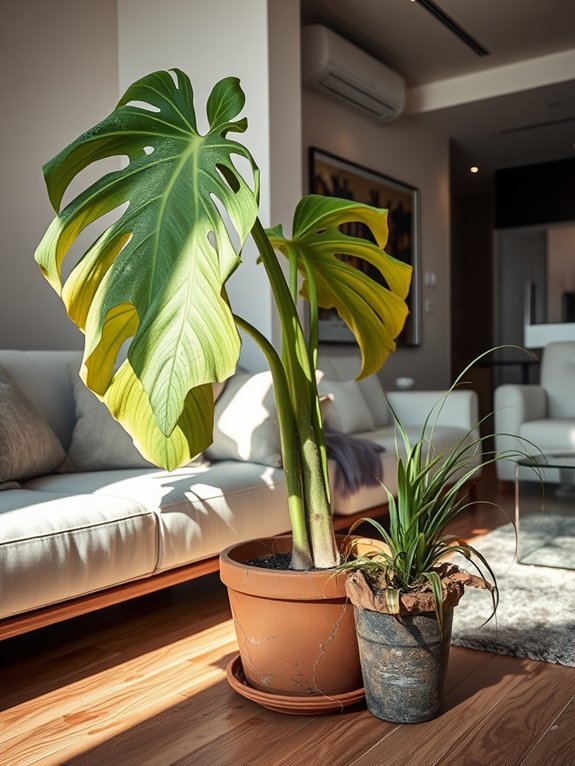
Even the most stunning living room plants can wilt under the weight of neglect! You might think they can thrive on their own, but plants need your love, too.
Regular watering, dusting off their leaves, and checking for pests are essential. Trust me, your plants won’t thrive on good vibes alone!
Don’t let them become the sad, forgotten corner of your living room. A little attention goes a long way, making them flourish and adding vibrancy to your space.
Using Non-Drainage Pots
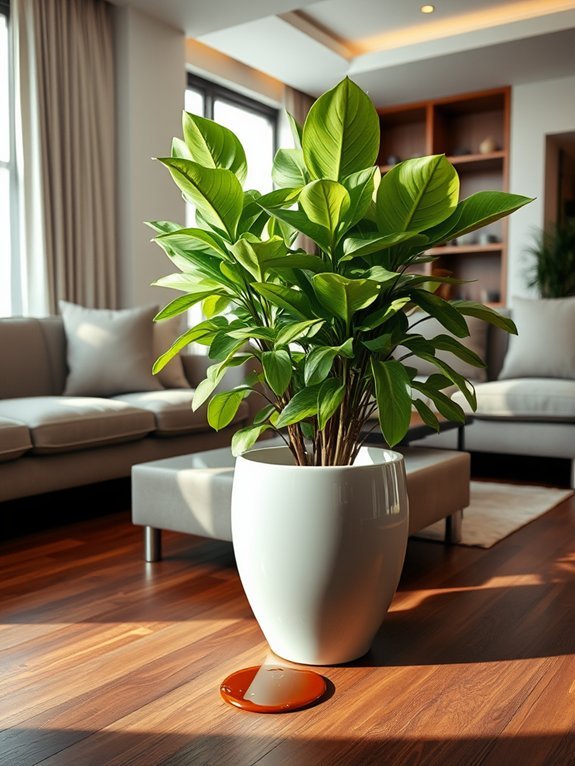
You might think that picking a beautiful pot for your plant is all you need to do, but choosing non-drainage pots could lead to a plant disaster!
Without drainage, water accumulates at the bottom, drowning your plant’s roots and causing root rot faster than you can say “green thumb.” It’s like giving your plant a lovely swimming pool but forgetting about the lifeguard!
So, always opt for pots with drainage holes or use a decorative pot as a cachepot. This way, your plant gets the love it deserves while you enjoy the beauty of your vibrant living room decor.
Happy planting!
Selecting Plants With Incompatible Styles

Have you ever walked into a room and felt like the plants were staging a fashion disaster? Mixing styles can create chaos rather than harmony.
Picture a sleek, modern space clashing with a wild, tropical jungle vibe—yikes! To avoid this, choose plants that complement your décor.
If you’ve got a minimalist look, go for clean lines with succulents or snake plants. On the flip side, if your room screams bohemian, let those lush ferns and vibrant pothos shine.
Failing to Consider Allergies
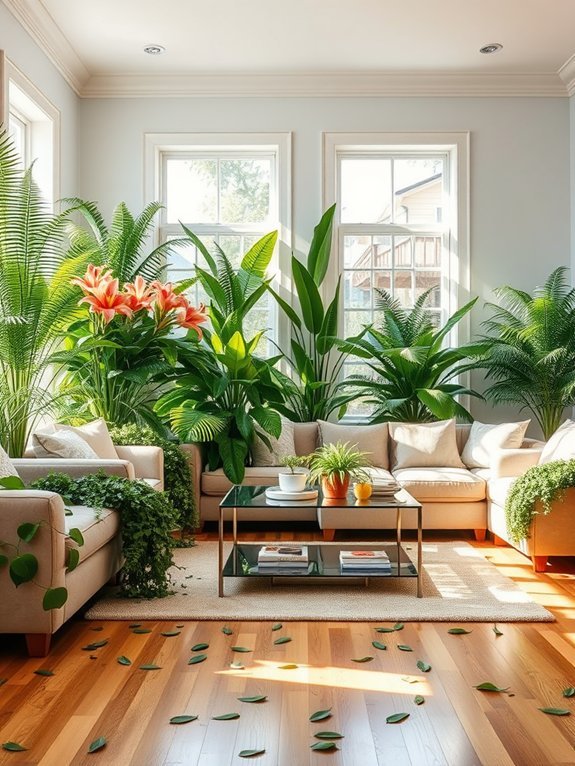
Did you know that some plants can turn your cozy living room into a sneeze-fest? It’s true! If you or your guests have allergies, you’ve gotta be careful with your choices.
For instance, certain plants, like ragweed and chrysanthemums, can trigger those pesky symptoms. Imagine trying to enjoy a movie while sneezing uncontrollably!
Instead, opt for low-allergen plants like spider plants or peace lilies. They’ll add beauty without the sniffles.
Always consider how your plant pals will affect your comfort. After all, you want your living room to be a sanctuary, not a sneezy battleground!
Choose wisely, and breathe easy!
Not Grouping Plants for Visual Impact
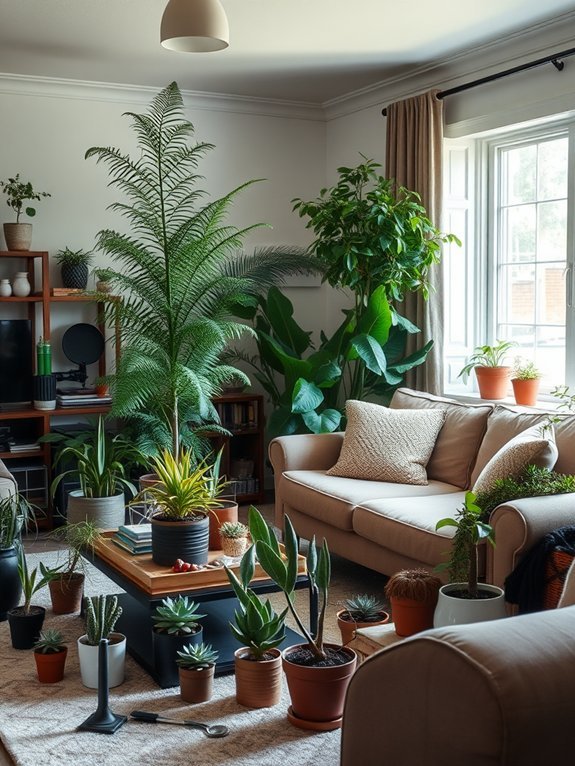
While it might seem tempting to scatter plants around your living room like confetti, grouping them together can truly elevate your decor game!
Imagine this: a cozy corner filled with lush greenery, creating a vibrant focal point that draws the eye. When you cluster plants of varying heights and textures, you add depth and interest to your space.
Plus, it makes watering and care a breeze! So, ditch the scattered approach and embrace the art of grouping. Your living room will thank you, and you’ll feel like a plant-parent pro.
Trust me, your friends will be green with envy!
Placing Plants in High-Traffic Areas
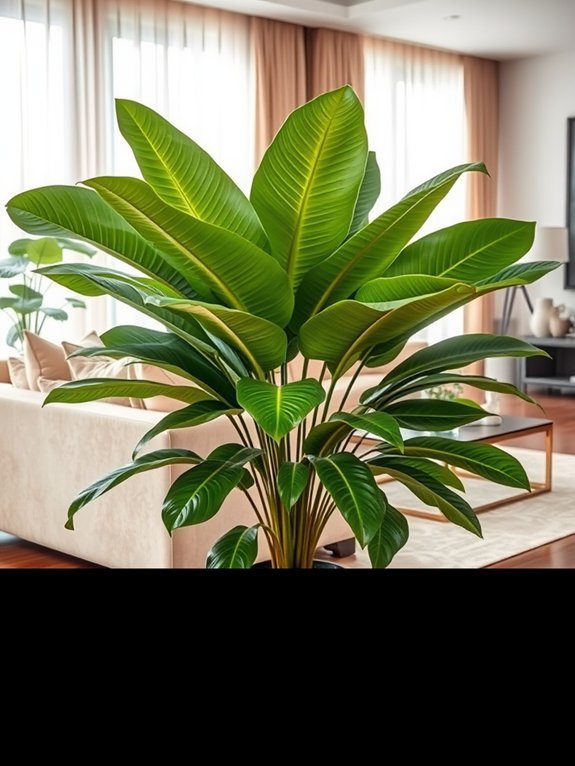
When you’re decorating your living room with plants, it’s easy to overlook one essential detail: placing them in high-traffic areas can lead to some unintended mishaps!
Imagine tripping over a potted palm or knocking a delicate fern off a shelf—yikes! You want your greenery to enhance your space, not become an obstacle course.
Instead, consider positioning plants in corners or on side tables, where they’ll be admired but won’t get jostled. This way, you can enjoy their beauty without the risk of a green disaster.
Trust me, your plants—and your shins—will thank you for it!
Overwatering or Underwatering Plants
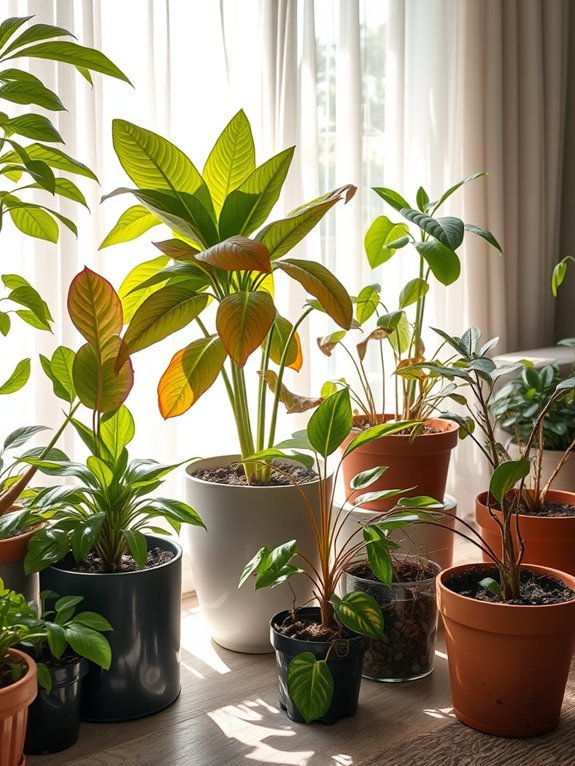
After you’ve carefully chosen the perfect spots for your plants, it’s time to focus on one of the biggest pitfalls that can turn your indoor jungle into a sad scene—overwatering or underwatering.
It’s like giving your plant a spa day or sending it to the desert! Check the soil; if it’s soggy, hold off on watering. Conversely, if it’s bone dry, your plant’s probably waving its little leaves for help!
Remember, different plants have different needs, so get to know your leafy friends. With a little attention, you’ll keep your greenery thriving and looking fabulous!
Happy plant parenting!
Choosing Toxic Plants for Homes With Pets

Choosing plants for your living room can feel like a fun adventure, but it’s crucial to steer clear of toxic options if you share your space with furry friends.
Your pets’ safety should always come first! Here are some common toxic plants you’ll want to avoid:
- Lilies: Beautiful, but deadly for cats!
- Pothos: Easy to care for, but can upset tummies.
- Philodendrons: Attractive, yet harmful if ingested.
- Sago Palm: A real stunner, but very toxic.
- Dieffenbachia: Looks great, but can cause serious irritation.
Keep your living space pet-friendly, and you’ll all thrive together!
Ignoring Seasonal Changes
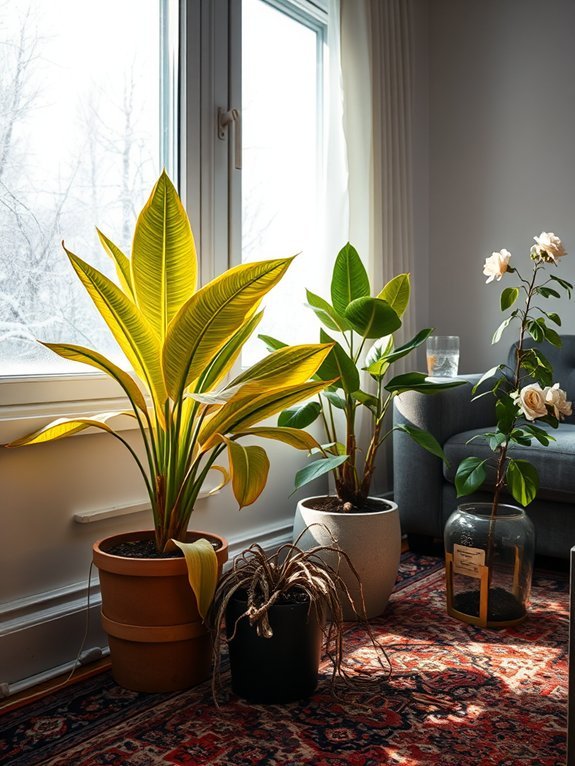
While keeping your furry friends safe from toxic plants is super important, it’s just as essential to pay attention to how the seasons affect your living room plants.
You wouldn’t wear winter boots in July, right? Your plants feel the seasonal shifts too! In winter, they might need less water and more light, while summer could mean extra hydration and humidity.
Ignoring these changes can lead to sad, droopy leaves—and nobody wants that! So, keep an eye on your plant pals, adjust their care routine, and watch them thrive.
After all, happy plants equal a happy home, and who doesn’t want that?
Not Considering Plant Growth Over Time

Just like you wouldn’t cram a growing teenager into their childhood bedroom, you can’t forget that your plants also need space to flourish!
When choosing your plant decor, consider their future growth. A cute little succulent might seem perfect now, but in a few months, it could outgrow its spot.
Here are some things to think about:
- Height: Will it reach the ceiling?
- Width: Will it take over the table?
- Light Needs: Does it need more sunlight as it grows?
- Pot Size: Is it going to need a bigger pot?
- Pruning: Will you be ready to trim?
Plan ahead, and your living room will thrive!
Using Poor Quality Soil
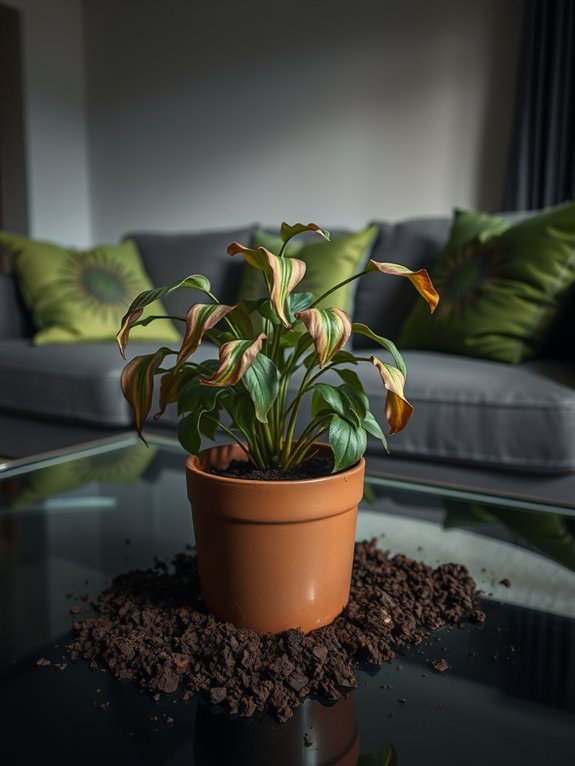
If you think you can skimp on soil quality and still have thriving plants, think again!
Using poor-quality soil is like feeding your plants junk food. They need nutrients to grow strong and vibrant, and cheap soil often lacks the essentials.
Plus, it can retain too much water or drain too quickly, leaving your green friends stressed. Nobody wants a sad plant!
Invest in good potting mix, and you’ll see the difference. Your plants will thank you with lush leaves and vibrant blooms.
Forgetting to Rotate Plants for Even Growth
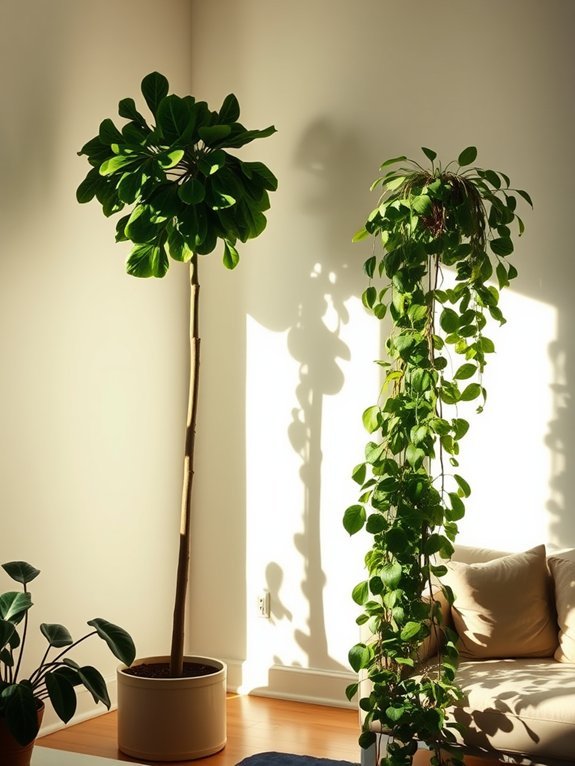
Using quality soil sets the stage for plant happiness, but it’s just one part of the equation. Forgetting to rotate your plants can lead to uneven growth, making them lean toward the light.
You want your leafy friends to thrive all around, so give them some love by turning them regularly! Here’s why you shouldn’t skip this step:
- Promotes even leaf growth
- Prevents leggy, awkward shapes
- Keeps your plant looking lush
- Enhances overall health
- Makes you a more attentive plant parent
Neglecting to Dust Leaves
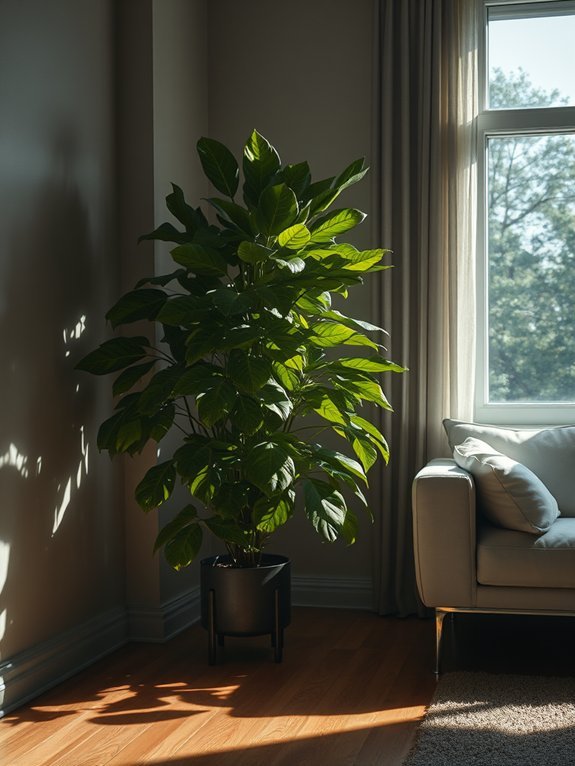
One of the easiest ways to show your plants some love is by giving their leaves a little dusting!
Dust can build up, making it tough for your leafy friends to soak up sunlight. Imagine trying to tan on a cloudy day—it just won’t work!
Grab a soft cloth and gently wipe those leaves, letting them shine. Not only does this help with photosynthesis, but it also keeps your plants looking fabulous.
Plus, it’s a great excuse to spend time with your greenery. So, don’t let that dust settle; your plants will thank you with vibrant growth and health!
Overlooking the Importance of Plant Stands
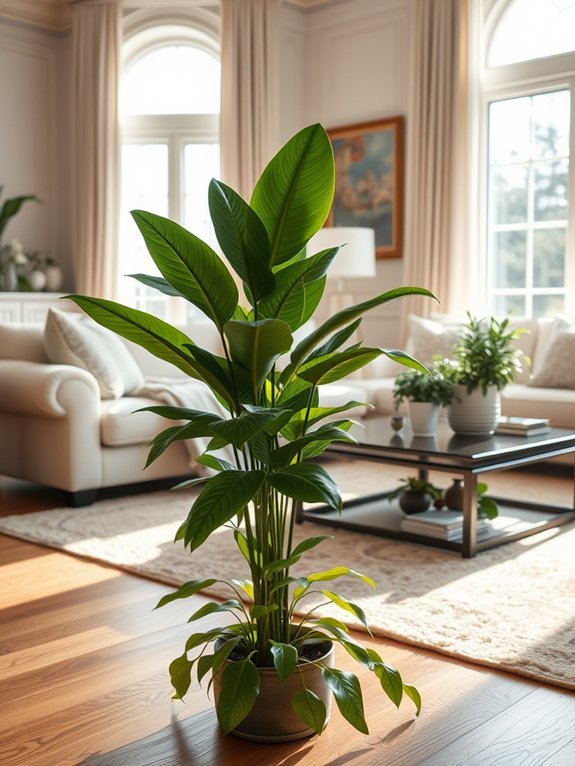
Plant stands might just be the unsung heroes of your living room decor! They elevate your plants, both literally and figuratively, adding that touch of sophistication.
Plus, they help create visual interest and balance in your space. Don’t underestimate their power!
Here’s why plant stands are essential:
- They maximize floor space by drawing the eye upward.
- They add height variation, making your display more dynamic.
- They prevent plants from getting too much direct sunlight.
- They protect surfaces from water damage.
- They let you showcase unique pots and planters!
Misplacing Plants Near Heat Sources
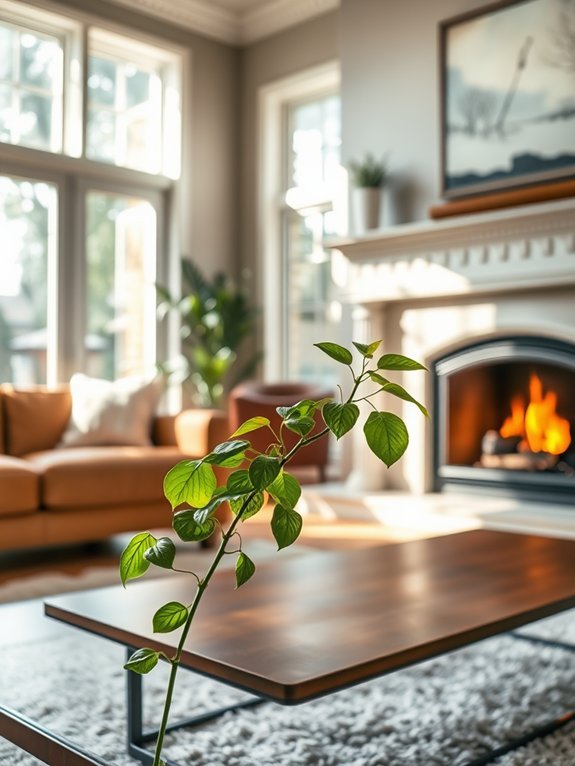
While it might seem convenient to place your beloved greenery near a cozy heat source, this little oversight can lead to some not-so-lovely consequences!
Your plants thrive best in stable environments, not in a sauna. Excessive heat can dry out the soil faster than you can say “Oops!” Plus, it can scorch those beautiful leaves, leaving them crispy and sad.
Instead, find a spot with bright, indirect light, far from radiators and fireplaces. Your plants will thank you for it, flourishing and bringing joy to your living room.
Using Plants as a Focal Point Without Balance
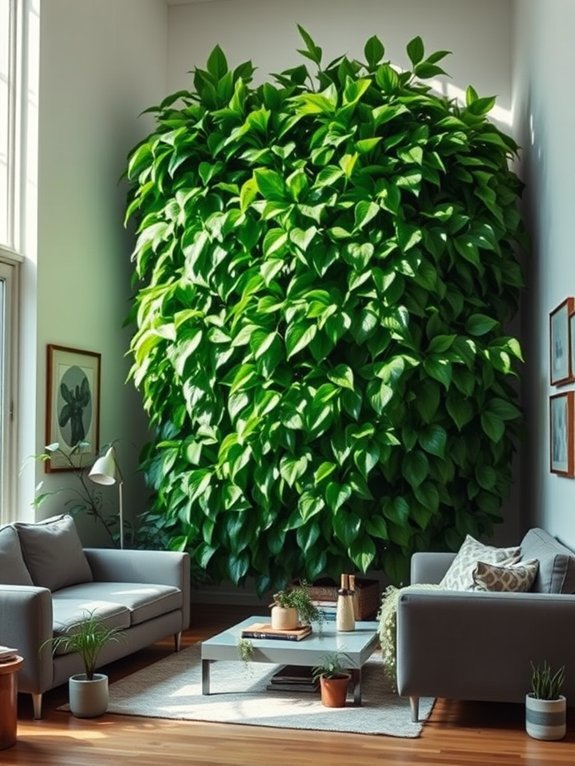
When you’re aiming to make your living room pop with greenery, it’s easy to get carried away and forget about balance.
Sure, a giant fiddle leaf fig looks stunning, but if it overshadows everything else, it can feel a bit one-sided.
To keep your space harmonious, consider these tips:
- Mix tall plants with shorter ones for height variation.
- Group plants in odd numbers for visual interest.
- Use different textures and colors to add depth.
- Consider the room’s flow; avoid clutter.
- Make sure plants aren’t competing for attention!
Finding balance keeps your living room vibrant and inviting, rather than overwhelming.
Choosing Invasive Plant Species

You might think that any plant can brighten up your living room, but choosing the wrong ones can lead to some serious headaches—especially if they’re invasive species.
These pesky plants can take over your space faster than a toddler on a sugar rush! Not only do they crowd out your other lovely greenery, but they can also damage your furniture or even your walls.
Imagine battling a plant that wants to conquer your home! Instead, opt for non-invasive varieties that bring charm without chaos.
Ignoring Plant Compatibility
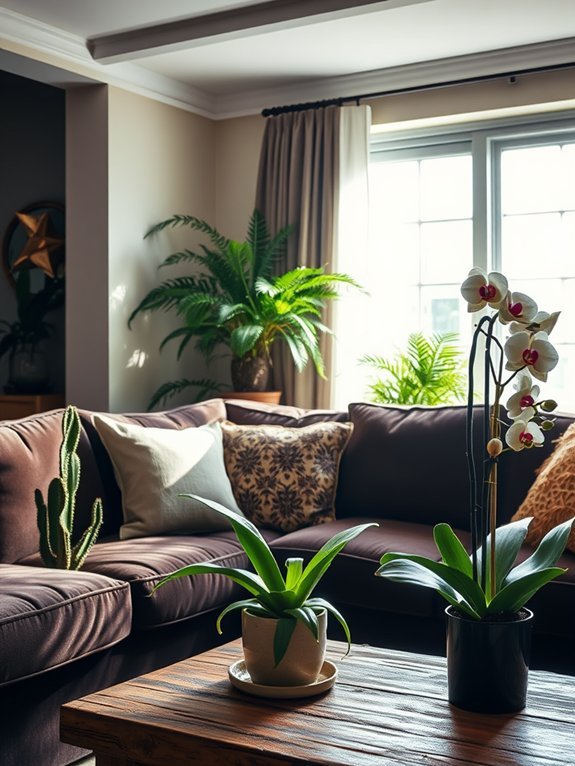
Plant compatibility is essential for creating a harmonious living room oasis that will make you smile every time you walk in.
Pairing plants that thrive in similar conditions can save you from a botanical disaster. Imagine your poor fern gasping for moisture while your cactus basks in the sun!
To keep your green friends happy, consider:
- Light requirements (sun, shade, or partial)
- Water needs (dry-loving vs. moisture-hungry)
- Humidity levels (tropical vs. arid)
- Growth habits (tall vs. short)
- Pest susceptibility (some plants attract more critters!)
Get it right, and your space will flourish with life!
Skipping Fertilization

Fertilization mightn’t seem like a big deal, but skipping it can leave your plants feeling a bit hangry!
Just like you need a balanced diet, your leafy friends crave nutrients to thrive. Over time, the soil loses its goodies, leaving your plants with a lackluster meal plan.
Don’t let them wilt in despair! A little fertilizer can work wonders, giving them the boost they need to flourish.
You don’t have to overdo it—just follow the instructions on the label, and your plants will reward you with vibrant leaves and maybe even a few blooms.
Happy fertilizing!
Underestimating Humidity Needs
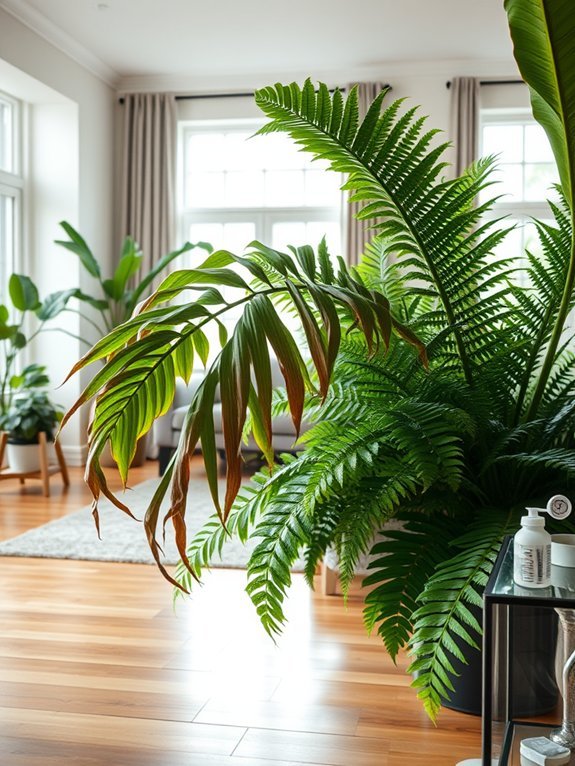
Have you ever wondered why your tropical beauty isn’t thriving as it should? One common culprit could be humidity! Many plants, especially those from humid climates, crave moisture in the air. If you’re not providing it, they might look droopy or brown.
Here are some signs you might be underestimating humidity needs:
- Leaf tips turning brown
- Leaves dropping unexpectedly
- Stunted growth
- Wilting, despite proper watering
- Fungal issues appearing
Don’t let your plants suffer! Consider misting them, using a humidifier, or placing a pebble tray underneath.
Your leafy friends will thank you with vibrant growth and lush leaves!
Overlooking Pest Control

While you’re busy ensuring your plants enjoy the right humidity, it’s easy to forget about another sneaky issue lurking in the shadows: pests!
These little critters can turn your leafy friends into their personal buffet. Regularly inspect your plants for tiny bugs, webs, or sticky residue. Trust me, a little prevention goes a long way!
You don’t want to discover a family of aphids throwing a party on your prized monstera. Use natural remedies or insecticidal soap to keep them at bay.
With a bit of attention, you can help your plants thrive and keep those unwelcome guests in check!
Failing to Personalize Plant Arrangements
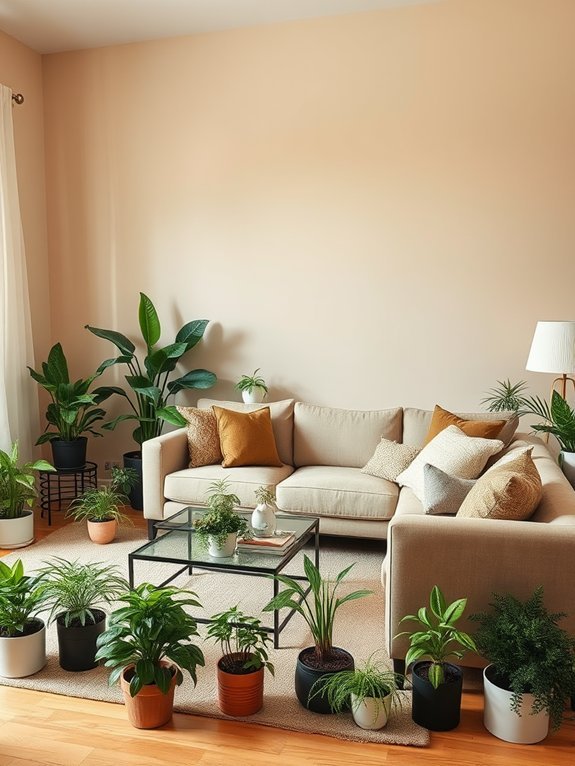
When you skip the chance to personalize your plant arrangements, you might miss out on creating a cozy and inviting vibe in your living room.
Plants are more than just decor; they’re a reflection of your personality!
Consider these fun ideas to make your arrangements uniquely yours:
- Choose pots that match your style, like boho, modern, or vintage.
- Mix different plant sizes for visual interest.
- Incorporate personal trinkets, like a favorite book or photo.
- Use colors that complement your room’s palette.
- Experiment with plant heights for a dynamic look.
Get creative and let your personality shine through!
Frequently Asked Questions
How Can I Tell if a Plant Is Pet-Friendly?
To tell if a plant’s pet-friendly, check for toxicity. Research the specific species online, consult your vet, or refer to reputable sources. Avoid plants like lilies or sago palms, which can harm your furry friends.
What Are the Best Plants for Low-Light Rooms?
If you’re looking for the best plants for low-light rooms, consider snake plants, pothos, or ZZ plants. They thrive in low light and require minimal care, making them perfect for your cozy spaces.
How Do I Know if My Plant Needs Repotting?
You’ll know your plant needs repotting if roots are growing through the drainage holes, the soil dries out quickly, or the plant appears stunted. Check for these signs to guarantee your plant stays healthy.
Can I Use Regular Garden Soil for Indoor Plants?
You can’t always use regular garden soil for indoor plants. It often lacks proper drainage and nutrients. Instead, opt for a specific potting mix designed for indoor plants to guarantee they thrive in your home.
What Are the Signs of a Pest Infestation on Plants?
You’ll notice signs of pest infestations on your plants if you see discolored leaves, sticky residue, or tiny webs. Check for holes in leaves and inspect the undersides regularly to catch any issues early.
Conclusion
Now that you know what to avoid, you’re ready to transform your living room into a plant paradise. Remember, it’s not just about having plants—it’s about making them feel at home too. With the right choices, you’ll create a lively and inviting space. Take your time and let your plants flourish, and soon your living room will be the talk of the town!
